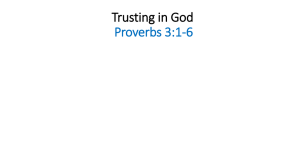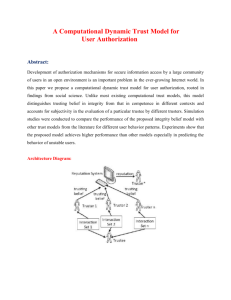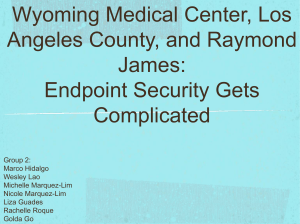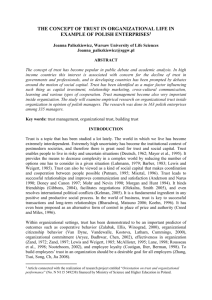Trust in Information Technology
advertisement
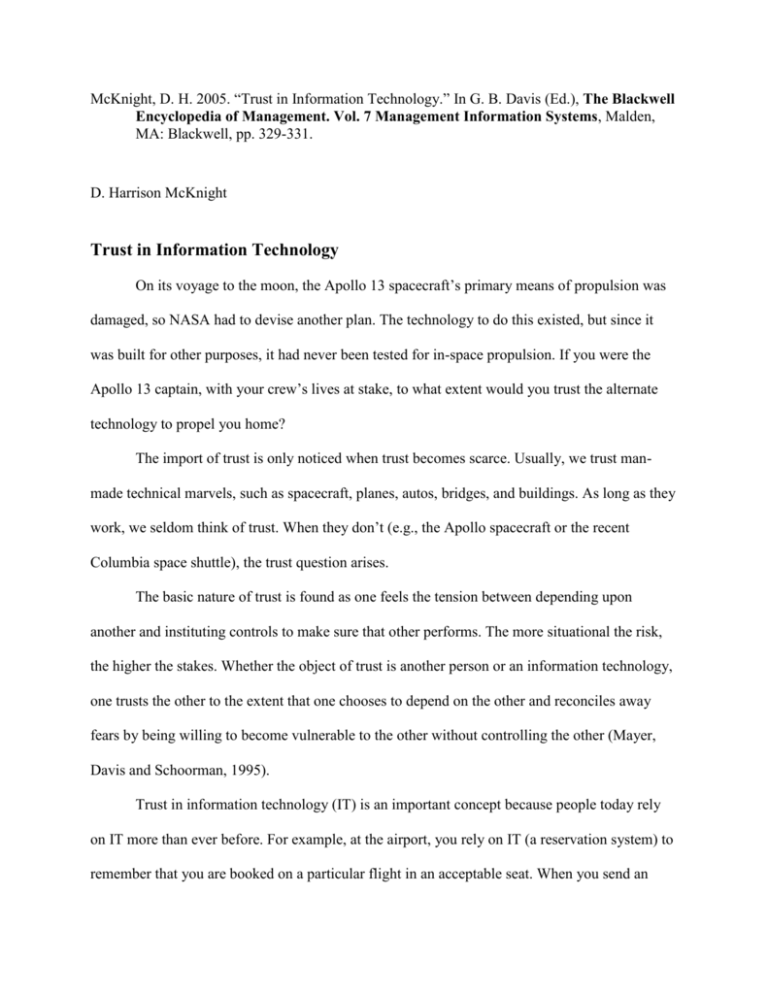
McKnight, D. H. 2005. “Trust in Information Technology.” In G. B. Davis (Ed.), The Blackwell Encyclopedia of Management. Vol. 7 Management Information Systems, Malden, MA: Blackwell, pp. 329-331. D. Harrison McKnight Trust in Information Technology On its voyage to the moon, the Apollo 13 spacecraft’s primary means of propulsion was damaged, so NASA had to devise another plan. The technology to do this existed, but since it was built for other purposes, it had never been tested for in-space propulsion. If you were the Apollo 13 captain, with your crew’s lives at stake, to what extent would you trust the alternate technology to propel you home? The import of trust is only noticed when trust becomes scarce. Usually, we trust manmade technical marvels, such as spacecraft, planes, autos, bridges, and buildings. As long as they work, we seldom think of trust. When they don’t (e.g., the Apollo spacecraft or the recent Columbia space shuttle), the trust question arises. The basic nature of trust is found as one feels the tension between depending upon another and instituting controls to make sure that other performs. The more situational the risk, the higher the stakes. Whether the object of trust is another person or an information technology, one trusts the other to the extent that one chooses to depend on the other and reconciles away fears by being willing to become vulnerable to the other without controlling the other (Mayer, Davis and Schoorman, 1995). Trust in information technology (IT) is an important concept because people today rely on IT more than ever before. For example, at the airport, you rely on IT (a reservation system) to remember that you are booked on a particular flight in an acceptable seat. When you send an important package by express mail, you rely on IT to tell you, hour by hour, whether the package has arrived. When you deal with cash transactions at a bank ATM, you rely on the system both to track your transactions accurately and to prevent others from accessing either your money or your account information. When you buy items on sale, you expect the point-of-sale system to ring up the correctly discounted price. The Internet has increased reliance on IT by encouraging millions to download music or software, upload digital pictures, buy goods, or seek new information or new services. Because of the Internet’s open, non-secured structure, trust in the Web itself is an issue. Trust in IT has to do with relying or depending on infrastructure systems like the Web or relying on specific information systems like Microsoft Excel. Formally, the overall trust concept means secure willingness to depend on a trustee because of that trustee’s perceived characteristics (Rousseau et al., 1998). Three main types of applicable trust concepts are used: 1. trusting beliefs, 2. trusting intentions, and 3. trusting behaviors. These concepts are connected. 1. Trusting beliefs means a secure conviction that the other party has favorable attributes (such as benevolence, integrity, and competence), strong enough to create trusting intentions. 2. Trusting intentions means a secure, committed willingness to depend upon, or to become vulnerable to, the other party in specific ways, strong enough to create trusting behaviors. 3. Trusting behaviors means assured actions that demonstrate that one does in fact depend or rely upon the other party instead of on oneself or on controls. Trusting behavior is the action manifestation of willingness to depend. Each of these generic trust types can be applied to trust in IT. Trusting behavior-IT means that one securely depends or relies on the technology instead of trying to control the technology. For example, one who hits a Web site’s “Download now” button demonstrates a willingness to be vulnerable to the software sent to one’s computer—software that may contain viruses. Trusting intention-IT means one is securely willing to depend or be vulnerable to the information technology. This is the psychological state one possesses before hitting the “Download now” button. Trusting beliefs-IT means a secure conviction that the technology has desirable attributes. For example, one may believe the system sending the software is reliable, safe, and timely in completing its task. Most of these trust in IT definitions are very similar to their trust in people counterparts. The difference is the object of trust (McKnight and Chervany, 2001-2002)—a specific technology or technologies versus a specific person or set of persons. For example, just as you can behaviorally depend on a person (as in trusting behaviors) to do a task for you (such as calculating numbers), so you can behaviorally depend on a piece of software (e.g., a statistical system) to do a task for you, such as making a statistical computation. With trusting intentions, just as you are willing to depend on the person, you can be willing to depend on an IT. Similarly, you can as easily believe an IT has favorable attributes as you can a person. The major difference between trust in people and trust in IT lies in the applicability of specific trusting beliefs. People and technologies have both similar and different attributes, and those similarities and differences define which trusting beliefs apply. In terms of similarities, both an information technology and a person have the quality of competence in terms of what they can do. Trusting belief in a person’s competence means the person is perceived to have the capability to do a task or fulfill a responsibility. Trusting belief in an IT’s competence means the IT is perceived to have the functionality or functional capability to do some task the trustor wants done. Another example: People can be said to act in predictable or consistent ways. Similarly, a technology can be said to perform in predictable or consistent ways. With people, we say the person’s behavior is predictable, reliable, or easily forecast. With IT, we say the predictable system operates reliably, by which we mean it does what it is designed to do without frequent “crashing,” delays, or unexpected results. In terms of differences, whereas people can be described as having benevolence and integrity, these are harder to ascribe to IT without reverting to unwarranted anthropomorphisms. With trust in people, one trusts a morally capable and volitional human; with trust in IT, one trusts a human-created artifact with a limited range of behaviors that lacks both will and moral agency. Thus, one cannot ascribe moral or volitional attributes to information systems—only capabilities or predictabilities. One can’t say an IT cares (related to trusting belief-benevolence) or tells the truth (related to trusting belief-integrity). Further, when commercial airline pilots decide to turn the plane over to a co-pilot or to auto-pilot, their decision reflects comparisons of the co-pilot’s willingness and capability to fly the plane and the auto-pilot’s capability to fly the plane. Because technology lacks moral agency, trust in technology necessarily reflects beliefs about a technology’s capability rather than its will or its motives. Because auto-pilot technology has limited capabilities to deal with dangerous or unusual conditions, trust in the auto-pilot IT cannot be extended as far as can trust in a fully trained and experienced co-pilot. Trust in information technology has several interesting implications. First, trust in IT should influence use or adoption of a technology. Unless one trusts a software product to reliably fill one’s needs, why would one adopt it? Second, trust in IT is a general assessment of the technology that probably affects other IT perceptions, such as relative advantage or usefulness of the technology. Thus, it may influence beliefs and attitudes that affect intentions to use a technology. Trust in technology is built the same way as trust in people. When users first experience technology, signals of well-done user interfaces and good vendor reputations will build trust. Reliable, dependable, quality IT performance is the key over time. Effective help functions also improve trust in IT. The entire system infrastructure should demonstrate quality, for deficient software at one level may hurt perceptions at several levels. For example, system security issues must be addressed before an application is trusted. In addition to trusting beliefs, trusting intentions, and trusting behaviors, two other types of trust deserve mention—dispositional and institution-based trust (McKnight et al., 1998). Disposition to trust is an individual differences concept originating from personality psychology that means a tendency to trust general others. Its IT equivalent is disposition to trust IT, the general tendency to be willing to depend on technologies across a broad spectrum of situations and specific ITs. Institution-based trust is a concept from sociology that relates to structures and situational favorableness that support trust. In terms of IT, institution-based trust in IT means a belief that success with the specific technology is likely because, regardless of the characteristics of the specific technology, one believes either that the technical situation is favorable or that structural conditions like guarantees, contracts, or other safeguards exist. Both disposition to trust technology and institution-based trust in technology foster trusting beliefs, trusting intentions, and trusting behaviors regarding a specific technology. Mayer, R. C., Davis, J. H. and Schoorman, F. D. “An Integrative Model of Organizational Trust,” Academy of Management Review (20:3), July 1995, pp. 709-734. McKnight, D. H. and Chervany, N. L. “What Trust Means in E-Commerce Customer Relationships: An Interdisciplinary Conceptual Typology.” International Journal of Electronic Commerce 6(2), 2001-2002, pp. 35-59. McKnight, D. H., Cummings, L. L. and Chervany, N. L. “Initial Trust Formation in New Organizational Relationships,” Academy of Management Review (23:3), 1998, pp. 473-490. Rousseau, D. M., Sitkin, S. B., Burt, R. S. and Camerer, C. “Not So Different After All: A Cross-Discipline View of Trust,” Academy of Management Review (23:3), 1998, pp. 393404.

